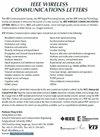Radar Point Cloud-Based Deep Learning Approach for High-Capacity Urban V2I Communications
IF 5.5
3区 计算机科学
Q1 COMPUTER SCIENCE, INFORMATION SYSTEMS
引用次数: 0
Abstract
With the evolution of 5G and 6G communication systems, sensing-assisted communication technology becomes essential for improving the operational efficiency of vehicle-to-infrastructure (V2I) systems. This letter proposes a radar point cloud-based deep learning (PDL) flow to achieve higher channel capacity between vehicles and base stations (BSs). Firstly, target-clutter segmentation is conducted using the proposed PDL based on the radar point clouds. With the segmentation results, a target clustering and tracking module is applied for a further step of false vehicle trajectory elimination. Finally, the deep learning-based method is deployed for intelligent communication beam classification of vehicles with the input of associated radar point cloud features. Numerical results show that the proposed approach improves channel capacity by approximately 10% over the deep neural network (DNN) and 2% over the DNN-based long short-term memory (LSTM) network. Meanwhile, it reduces the parameter count by about 85% compared to DNN and by 88% compared to LSTM-DNN, respectively.基于雷达点云的大容量城市V2I通信深度学习方法
随着5G和6G通信系统的发展,传感辅助通信技术对于提高车对基础设施(V2I)系统的运行效率至关重要。这封信提出了一种基于雷达点云的深度学习(PDL)流程,以实现车辆和基站(BSs)之间更高的信道容量。首先,利用所提出的基于雷达点云的PDL进行目标杂波分割;在分割结果的基础上,采用目标聚类与跟踪模块进行进一步的假车辆轨迹消除。最后,将基于深度学习的方法应用于输入相关雷达点云特征的车辆智能通信波束分类。数值结果表明,该方法比深度神经网络(DNN)的信道容量提高约10%,比基于DNN的长短期记忆(LSTM)网络的信道容量提高约2%。同时,与DNN和LSTM-DNN相比,它分别减少了约85%和88%的参数计数。
本文章由计算机程序翻译,如有差异,请以英文原文为准。
求助全文
约1分钟内获得全文
求助全文
来源期刊

IEEE Wireless Communications Letters
Engineering-Electrical and Electronic Engineering
CiteScore
12.30
自引率
6.30%
发文量
481
期刊介绍:
IEEE Wireless Communications Letters publishes short papers in a rapid publication cycle on advances in the state-of-the-art of wireless communications. Both theoretical contributions (including new techniques, concepts, and analyses) and practical contributions (including system experiments and prototypes, and new applications) are encouraged. This journal focuses on the physical layer and the link layer of wireless communication systems.
 求助内容:
求助内容: 应助结果提醒方式:
应助结果提醒方式:


